Have you checked your lift truck tires enough lately?
Probably not. But as you’re about to read, plenty of opportunities are available to spend too much too often if you ignore proper maintenance.
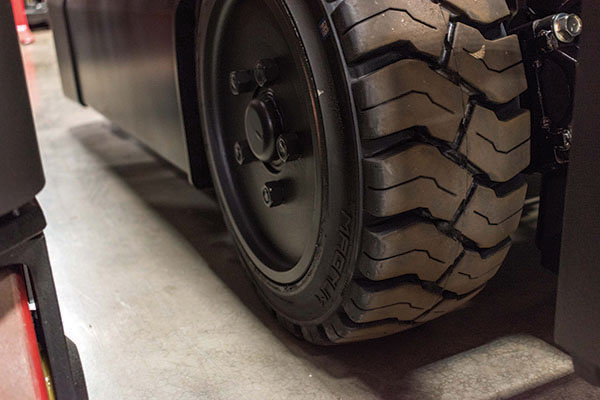
So, what exactly do you know about lift truck tires? The standard answer is: They’re black, round and roll. And at that point, most people run out of details. Trouble is, lift truck tires are a complicated consumable, and they require regular attention.
“Tires are one of the highest cost maintenance components of lift trucks. It is not uncommon for them to account for 30% of fleet maintenance costs,” according to Kristian Rendtorff, fleet manager at Associated, one of Raymond’s largest dealers.
In fact, tires can stop being all that round and rolling all that well for plenty of reasons. It’s the case whether the tires are solid, cushion or pneumatic or made of rubber or polyurethane. The danger zones for all tires are heat, wear, abuse and misapplication. A solid maintenance program is the best way to monitor tire wear and ensure you are getting the right balance of tire performance and life.
Start with tire selection
Interestingly, tire maintenance actually starts with tire selection. In the end, say the experts, tire maintenance is all about performance out on the floor.
“If you don’t have the right tires on the truck, it won’t run or stop as it should,” says Tyler Nations, account manager at Thombert.
To begin, several options are available when it comes to materials and design.
Materials options are rubber and polyurethane. But, it’s not an on/off switch. Tire manufacturers offer many different compounds including custom ones for specific applications.
For instance, standard rubber tires suffice for most general warehouse use. But in freezers, a special compound is typically added to a rubber tire to improve traction.
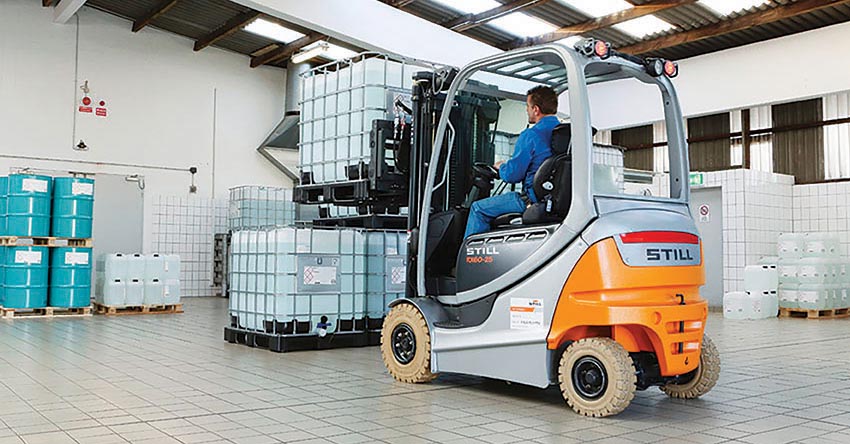
Non-marking white rubber compound as well as polyurethane tires are well suited to food and pharma applications.
Meanwhile, some industries such as food and pharma require non-marking tires. That precludes use of standard carbon black rubber tires. Options here are either a non-marking rubber compound without carbon black or standard polyurethane tires.
Design options fall into two broad categories. Rubber tires are either solid/cushion or pneumatic. Polyurethane tires are solid. Rubber tires are used primarily on internal combustion (IC) trucks. Polyurethane is primarily used on electric narrow aisle trucks as well as motorized hand trucks.
The other design issue focuses on traction requirements. Smooth tires and tires with tread are available. Tire suppliers and lift truck dealers are experts at making the right choice here.
It’s also worth noting that tires do serve another, often overlooked purpose—cushioning the lift truck and its loads. But, even that is a series
of tradeoffs.
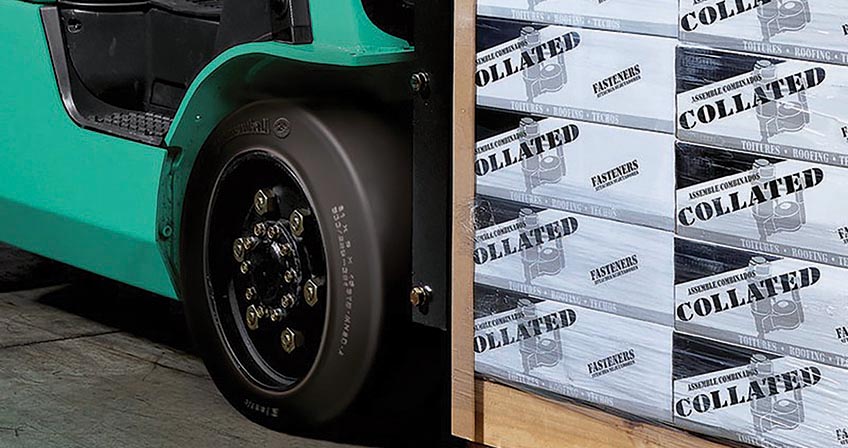
Performance capabilities of tires depend on the application and rubber compound selected.
Pneumatic tires offer excellent cushioning capabilities but are susceptible to punctures from foreign objects on the shop or warehouse floor. On the flip side, solid/cushion tires allow heat to build up especially during long runs, relatively decreasing their cushioning capability.
The performance capabilities of rubber and polyurethane tires vary. Specifics always depend on the application and tire compound selected. In addition, performance will vary depending on the tire material and design.
“The best approach to tire selection is to buy the tire best suited to the job regardless of upfront cost,” says Jim Caruso, business development manager at Trelleborg Wheel Systems. “It is usually more cost effective to go with a premium tire that holds up the application,” he adds.
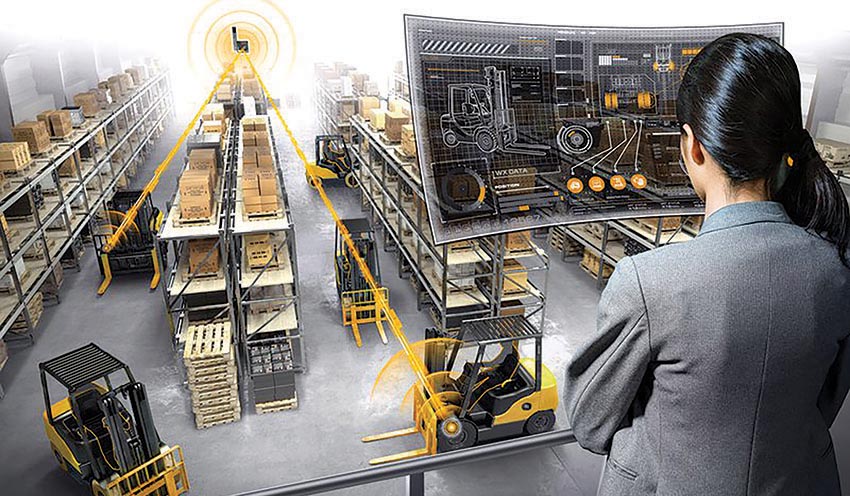
A digital monitoring platform tracks tire heat and pressures remotely throughout the warehouse.
Enemies of tires
When it comes to tire maintenance, several factors can reduce tire life. These range from heat and wear to floor debris and aggressive drivers. Some of these you can control, others not so much.
“Heat is a tire’s worst enemy,” says Caruso.
When lift trucks accelerate, decelerate and run in the warehouse, heat builds up regardless of tire type. “You want the coolest running tire possible,” explains Trelleborg senior technical manager Steve Petrescu.
Heat buildup stresses different tires in different ways. If they run too hot, polyurethane tires fail from hysteresis where the polyurethane actually liquefies in the tread. Rubber tires stress crack under excessive heat. Both problems shorten tire life.
“Wear resistance is another other major consideration,” says Matt Futrelle, sales and marketing manager for commercial specialty tires at Continental Tire the Americas.
The tire’s wear resistance depends on several factors. Selecting the right compound for the application is paramount. But other considerations range from debris on the floor to the driving habits of operators. The former can cut tires and even remove chunks. Drivers create flat spots on tires by starting and stopping too aggressively.
Caruso of Trelleborg emphasizes house cleaning as a key factor in maintaining tire life. And, he’s not just talking about picking up the occasional steel band on the floor or broken pallet parts. He includes elements of the floor itself such as rough floor seams and raised expansion joints. Running over dock plates can have much the same effect.
Still another cause of premature tire wear, says Associated’s Rendtorff, is excessively driving the truck in a single, circular route, much like NASCAR racing. “The result is coning which tapers the tire, bringing it out of round,” he says.
With pneumatic tires in particular, inflation is a determiner of wear. Tires need to be inflated to proper levels to maximize service life.
Nations of Thombert identifies some other enemies of tires. Leaders here are include the intensity of the application and frequency of use.
Tires, he says, have to be replaced more frequently if trucks make long runs with heavy loads. The heat buildup can cause stress cracking on side walls that shorten tire life. This problem is exacerbated if the truck consistently moves loads at near its capacity rating. Excessive speed has much the same effect.
Frequent movement of loads that are too light can be a problem, too, says Petrescu. As an example, he cites a 5,000-pound capacity truck that constantly carries loads under 1,000 pounds.
“That truck is better off carrying loads of 2,500 to 3,000 pounds. Lighter loads actually stress the truck’s steer tires because the load doesn’t balance out the counterweight above them,” Petrescu adds. The result is stress cracking and radial cracking.
As nice as it would be to predict the life of tires, it really can’t be done. Futrelle simply says there is no average life of a tire. It could be a range as wide as 4,000 to 7,000 hours, depending on operating conditions.
Instead, the bottom line, says Futrelle, is “getting the most hours out of a tire without them being ripped, cut, torn or cracked.”
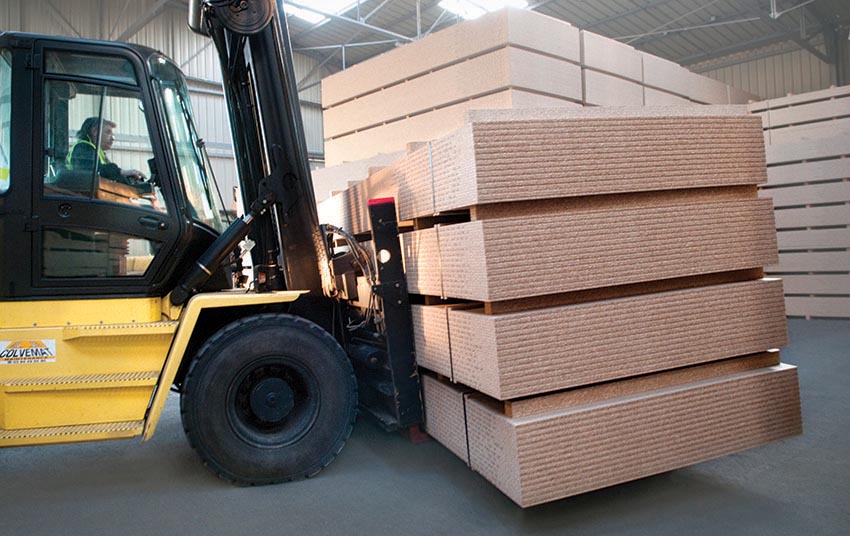
Tires need more frequent replacement if trucks carry heavy loads and make long runs.
Monitoring tire condition
“Every company with a lift truck fleet needs to build a maintenance program to manage both tire performance and costs,” says Rendtorff. “Unfortunately, too many companies are not very good at this, compromising both service levels and their own bottom line,” he adds.
That creates a pinch point, but one that can be managed.
In the past couple of years, lift truck suppliers have made a push on increasing telematics capabilities. At last count, one supplier was recording data to establish metrics from more than 70 different sensors on its trucks. Unfortunately, tire condition is not part of that or any other telematics program.
Tire suppliers are making a run at this, however.
Trelleborg offers a wear gauge to manually measure tread life on tires. The company also builds into some tires a colored wear line that indicates when replacement is needed.
A digital handheld tool and a digital monitoring platform are available from Continental. The former is mounted in the truck and monitors pressures and heat, displaying the data on a small monitor. The platform, called ContiConnect, is a centralized system that remotely monitors tire pressure and heat in real time across a facility’s entire fleet. It is being rolled out in pilot programs worldwide.
While those are two data collection tools, they are only one part of a tire maintenance program.
Rendtroff says a tire program should be part of a company’s overall truck maintenance regimen. He says doing it right can reduce tire maintenance costs by 20%.
The starting point, says Rendtorff, is to collect accurate lift truck maintenance costs. “Most companies have bits and pieces here that are both incomplete and inconsistent,” he explains.
While not enough by itself, complete and accurate data is essential to determining the root cause of tire maintenance problems. “That’s essential to hitting that 20% savings goal,” says Rendtorff.
With all of that in place, a company should then build a pilot program to tightly monitor a small number of trucks initially. As this proves its worth, maintenance monitoring can be extended out to an entire fleet and even multiple locations.
The good news, Rendtorff, explains, is that companies don’t have to go it alone. Certain lift truck dealers are equipped to be a partner. Similarly, tire suppliers have maintenance programs in place, too. Or, as Futrelle says, “most want a turnkey program. If you have to think about your tires, then you probably have the wrong vendor.”
While lift truck tires are black, round and roll, maintenance is quite a bit more complicated. In fact, there’s real money up for grabs here. Not to mention improved operational efficiency and fewer unexpected headaches. Probably worth some time this week.
Companies mentioned in this article:
Associated, a Raymond dealer
Continental Tire the Americas
Thombert
Trelleborg Wheel Systems

Article Topics
Latest in Logistics
DAT March Truckload Volume Index sees modest March gains National diesel average, for week of April 22, is down for the second straight week UPS reports first quarter earnings declines LM Podcast Series: Assessing the freight transportation and logistics markets with Tom Nightingale, AFS Logistics Investor expectations continue to influence supply chain decision-making The Next Big Steps in Supply Chain Digitalization Under-21 driver pilot program a bust with fleets as FMCSA seeks changes More LogisticsSubscribe to Logistics Management Magazine

Find out what the world's most innovative companies are doing to improve productivity in their plants and distribution centers.
Start your FREE subscription today.
April 2023 Logistics Management

Latest Resources














